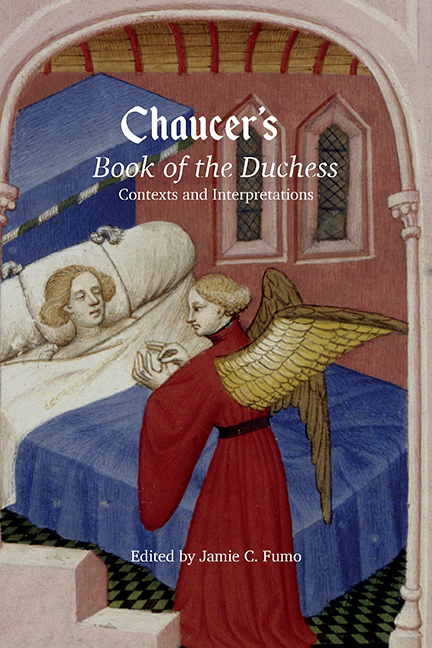Book contents
- Frontmatter
- Contents
- List of Illustrations
- Acknowledgments
- List of Contributors
- Abbreviations and Editions
- Introduction: Reopening the Book of the Duchess
- I Books and Bodies
- II The Intertextual Duchess
- 5 Alcyone's Grave: Inscription and Intertextuality in Chaucer, Spenser, and Ovid
- 6 Tribute to a Duchess: The Book of the Duchess and Machaut's Remede de Fortune
- 7 ‘Hyt am I’: Voicing Selves in the Book of the Duchess, the Roman de la rose, and the Fonteinne Amoureuse
- 8 ‘Counterfeit’ Imitatio: Understanding the Poet-Patron Relationship in Machaut's Fonteinne amoureuse and Chaucer's Book of the Duchess
- 9 The Shock of the Old? The Unsettling Art of Chaucer's Antique Citations
- 10 Response: The Book of the Duchess, Guillaume de Machaut, and the Image of the Archive
- Bibliography
- Index
- Miscellaneous Endmatter
6 - Tribute to a Duchess: The Book of the Duchess and Machaut's Remede de Fortune
from II - The Intertextual Duchess
Published online by Cambridge University Press: 18 April 2018
- Frontmatter
- Contents
- List of Illustrations
- Acknowledgments
- List of Contributors
- Abbreviations and Editions
- Introduction: Reopening the Book of the Duchess
- I Books and Bodies
- II The Intertextual Duchess
- 5 Alcyone's Grave: Inscription and Intertextuality in Chaucer, Spenser, and Ovid
- 6 Tribute to a Duchess: The Book of the Duchess and Machaut's Remede de Fortune
- 7 ‘Hyt am I’: Voicing Selves in the Book of the Duchess, the Roman de la rose, and the Fonteinne Amoureuse
- 8 ‘Counterfeit’ Imitatio: Understanding the Poet-Patron Relationship in Machaut's Fonteinne amoureuse and Chaucer's Book of the Duchess
- 9 The Shock of the Old? The Unsettling Art of Chaucer's Antique Citations
- 10 Response: The Book of the Duchess, Guillaume de Machaut, and the Image of the Archive
- Bibliography
- Index
- Miscellaneous Endmatter
Summary
Sometime after the death of Blanche of Lancaster, the wife of John of Gaunt, in 1368, Geoffrey Chaucer undertook to compose the poem that he called The Death of Blanche the Duchess, now generally known as the Book of the Duchess. As its original title suggests, the poem is topical: the recall in its opening section of the tragic Ovidian tale of Seys and Alcyone and the definitive closing pronouncement ‘She ys ded’ (1309) frame it with dramatic revelations of the death of a beloved spouse and the despairing grief of the bereaved partner. This response to the death of the wife of the most powerful prince of the realm has also been termed ‘the first clear instance of “courtly” literature in English’, a suggestion due in part to its borrowing from a substantial number of French poems.
Here I examine the strong intertextual presence in the Duchess of the Remede de Fortune (after 1341, and before 1357), one of the major dits of Guillaume de Machaut, against the background of what Elizabeth Salter has aptly characterized as ‘the cosmopolitan years’ that followed the Battle of Poitiers in 1356, during which the ‘captivity’ of King John II of France and his sons intensified the already considerable prominence of French courtly poetry in England. That presence is particularly prominent in the longest segment of the Duchess, the story told by the Man in Black, which in its telling closely follows the account in the Remede of the origin, development, and effects of love for a highborn lady widely known for both her beauty and her virtue. The lady of the Remede, generally acknowledged to be John II's first wife Bonne of Luxembourg, is identified by the narrator as ‘ma dame, qui est clamee / De tous sur toutes belle et bonne. / Chascun par droit ce non li donne’ (54–6) [my lady, who is proclaimed by all to be the most beautiful and best above all. Everyone rightly gives her this name]. This discreet but transparent anonymity enables the depiction of her beauty and goodness with an intimacy and candor that might well have appeared presumptuous in the poet's own voice even within the courtly fiction in which he portrays her.
- Type
- Chapter
- Information
- Chaucer's Book of the Duchess , pp. 119 - 134Publisher: Boydell & BrewerPrint publication year: 2018

